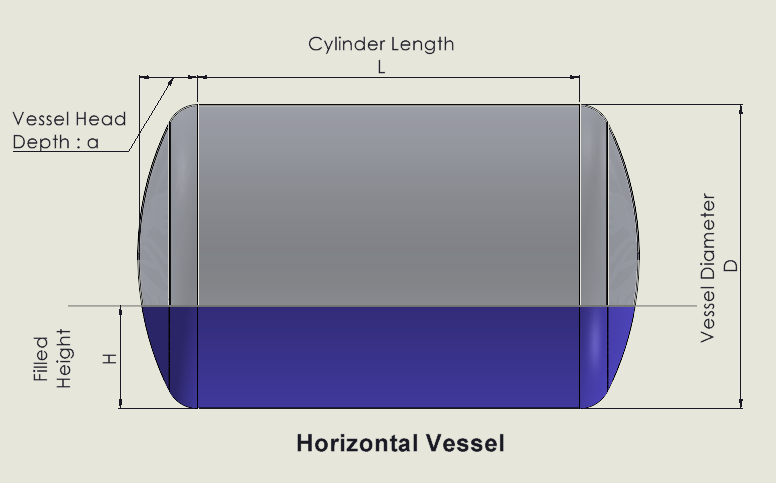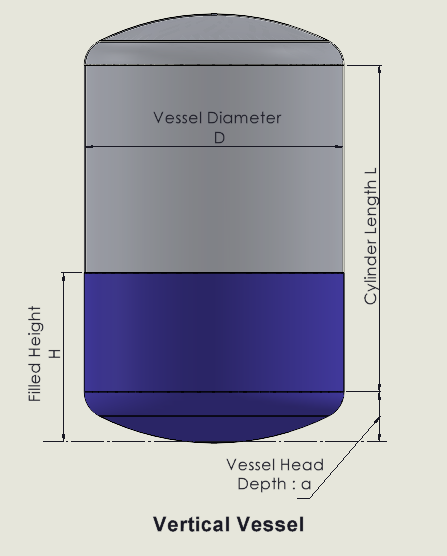Vessel Volume & Level Calculation
Vessel volume & level calculation ensures that every millimetre of liquid height converts into an accurate capacity value—across vertical and horizontal tanks. SV Industries provides a practical, engineer-friendly approach so your operators get trustworthy inventory numbers, faster batches, and cleaner audits.
🎯 What this covers
Works for common head geometries: ellipsoidal (2:1), hemispherical, torispherical (ASME F&D / standard / 0.8:0.1), and flat.
Handles both orientations with correct level reference: vertical (from bottom apex) and horizontal (0…D).
Unit flexibility: mm, m, inch—with consistent conversions.
vessel volume & level calculation
Inputs
Bottom head
Top head
Live visual preview
Results
| Level % | Level (unit) | Volume (m³) | Volume (L) | Volume (gal, US) |
|---|
Quick Start (2-minute Guide)
Follow these fast steps to get accurate level → volume in minutes. No CAD, no spreadsheets—just enter your geometry and download the calibration.
- 🧭 Choose Orientation
Select Vertical (H measured from bottom apex) or Horizontal (H ranges 0…D).
Tip: Horizontal tanks: 10% level = 0.1 × D (e.g., D=1000 → 100 mm). - 📐 Set Units
Pick mm, m, or inch. The calculator converts consistently—no rounding surprises across results. - ⌀ Enter Internal Dimensions
- Diameter (D) — internal only
- Straight length/height (L) — shell length excluding heads
If you’re sizing a new build, see our vessel options: Reactor Vessel or SS Jacketed Vessel.
- 🧩 Select Bottom & Top Head Types
Choose from Ellipsoidal (2:1), Hemispherical, Torispherical (ASME F&D / Standard / 0.8/0.1), or Flat.
Note: Head geometry affects dish depth and total capacity—match your fabrication drawing. - 📏 Enter Filled Level (H)
- Vertical: H from the bottom apex upward.
- Horizontal: H from lowest point; valid range 0…D.
- 🔁 Pick Calibration Step
Select 5% or 10% to generate a clean Level–Volume table suitable for SOPs and ERP upload. - ▶️ Review Live Visual & Results
The preview shows liquid fill (SV brand color), while outputs display Filled Volume, Total Volume, and a Level–Volume chart.
Need custom validation for your tank? Contact Us. - ⬇️ Export
- CSV for spreadsheets/ERP
- Print/PDF for QA files and audits
Want examples? Browse our latest posts in the Blog.
Pro tip: Mixing or heat-transfer constraints in real plants (coils, jackets, baffles) can change effective working capacity. Explore Limpet Coil Reactors to align calculation with actual process hardware.


Supported Head Types
Right head selection = right capacity. Our calculator models the most-used geometries exactly—so your level-to-volume stays reliable across builds and standards.
| Head Type | Depth (a) | Geometry / Parameters | Typical Use | Why it helps | Explore |
|---|---|---|---|---|---|
| Ellipsoidal (2:1) | a = D / 4 |
2:1 ellipse; R/r not required | Reactors, jacketed vessels | Balanced capacity without excessive height; good for agitator clearances | Reactor Vessel · SS Jacketed |
| Hemispherical (“Spherical” Head) | a = D / 2 |
Half-sphere cap; R/r not required | Higher pressure / thermal cycling | Best stress distribution; maximizes end-cap volume | Process Reactor |
| Torispherical (ASME F&D) f=1 · k=0.06 |
R = f·D = Dr = k·D = 0.06Da = R − √((R−r)² − (A−r)²), A=D/2
|
Crown + knuckle per ASME | Industry default for many vessels | Predictable fabrication; balanced height & capacity | Reactor Vessel |
| Torispherical (Standard F&D) f=1 · k=0.1 |
R = Dr = 0.1Da as per formula above
|
Gentler knuckle radius | Hygiene + fabrication friendly | Smoother transitions may improve local stresses & cleanability | SS Jacketed |
| Torispherical (F&D) f=0.8 · k=0.1 |
R = 0.8Dr = 0.1Da increases due to tighter crown
|
Designs needing deeper dish | Modifies end-volume & headroom; model captures exact change | Industrial Reactor | |
| Flat | a = 0 |
Flat plate; R/r not applicable | Atmospheric/low-pressure, removable covers | Simple fabrication; lowest added head volume | Products |
Vertical vs Horizontal — Level Reference
Reference point: bottom head apex (deepest internal point).
Htotal = abottom + L + atop (dish depths + straight length; all values are internal).
- 0 ≤ H ≤ abottom — filling the bottom head.
- abottom < H ≤ abottom + L — cylindrical shell region.
- abottom + L < H ≤ Htotal — top head (complement).
Sight-glass or transmitter zero should align with the apex datum to avoid offset errors.
Considering a new build? Explore Reactor Vessels and SS Jacketed Vessels.
Reference point: the lowest internal point of the shell.
Valid H range: 0 … D (diameter). Example: if D = 1000 mm, then 10% level = 100 mm.
- H = 0 — empty; H = D/2 — ~50% cylinder area (heads added via integration).
- H = D — full (cylinder + both heads at full).
- Transmitter “0%” at the drain datum; “100%” at top-of-ID. Record actual D during commissioning.
Validation & Sample Cases
- Inputs: D = 1000 mm, L = 2000 mm; Bottom head = Top head = Torispherical (ASME F&D, f=1, k=0.06)
- Expected dish depth (each): a ≈ 169.34 mm
- Total level range: Htotal = abottom + L + atop ≈ 2338.68 mm
- Total volume: ≈ 1.7328 m³ (±0.2%)
- Sanity: 100% level ≈ 2338.7 mm; total volume matches.
Inputs: D = 1000 mm, L = 2000 mm; Left/Right heads = Flat
Cylinder volume (exact): A = D/2 = 500 mm → Vcyl = π·A²·L = π·500²·2000 mm³ ≈ 1.570796 m³
| Level H (mm) | Expectation | Volume (m³) |
|---|---|---|
| 0 | Empty | 0 |
| 500 (D/2) | ~Half cylinder area | ≈ 0.785398 |
| 1000 (D) | Full cylinder | ≈ 1.570796 |
- Inputs: D = 1000 mm, L = 2000 mm; Bottom/Top = Hemispherical
- Dish depth (each): a = D/2 = 500 mm
- Per-head volume (exact): Vhead = (2/3)·π·A³ = (2/3)·π·500³ mm³ ≈ 0.261799 m³
- Total volume: V ≈ Vcyl + 2Vhead ≈ 1.570796 + 0.523599 = 2.094395 m³
- Total level range: Htotal = 500 + 2000 + 500 = 3000 mm
- Level datums: Vertical → bottom apex; Horizontal → 0…D (lowest to highest internal point).
- Units & rounding: Keep all inputs in one unit; export CSV and verify with your ERP sheet.
- Head selection: Match fabrication drawing (ASME F&D vs Standard vs 0.8/0.1) to avoid skew.
- Visual preview: Shape & meniscus should reflect orientation/heads; compare with vessel photos in the Gallary.
Need validation against P&IDs or as-built drawings? We can align calibration to your Reactor Vessel or SS Jacketed Vessel and provide signed QA PDFs — Contact Us.
Frequently Asked Questions (FAQs)
How do I calculate vessel volume from liquid level?
Enter internal Diameter (D), straight Length/Height (L), select head types for both ends, choose orientation, and input level (H). The calculator converts H → Volume instantly.
Should I use internal diameter (ID) or external diameter (OD)?
Use internal dimensions only.
Which head type should I select if drawings aren’t clear?
If unknown, ASME F&D (f=1, k=0.06) is a practical default in many plants.
Do jackets or limpet coils change the capacity?
External jackets do not change internal volume; limpet coils usually don’t either unless they intrude inside.
Does the agitator (anchor, PBT, hydrofoil) affect level-to-volume?
If the agitator/shaft/baffles intrude inside, they reduce capacity slightly.
The tank is slightly tilted—will calibration be wrong?
Yes, even small slope/tilt shifts the level-to-volume curve.
Can I mix different head types on top and bottom (or left/right)?
Yes—select per-end head types.


